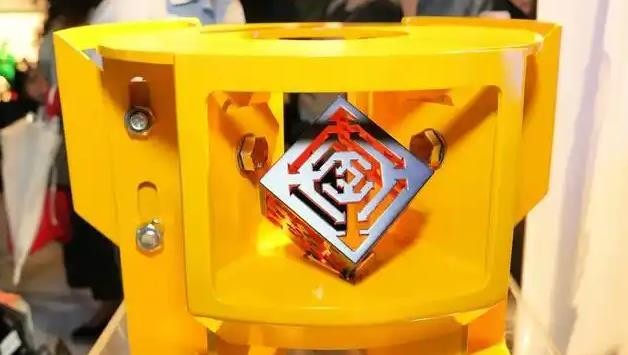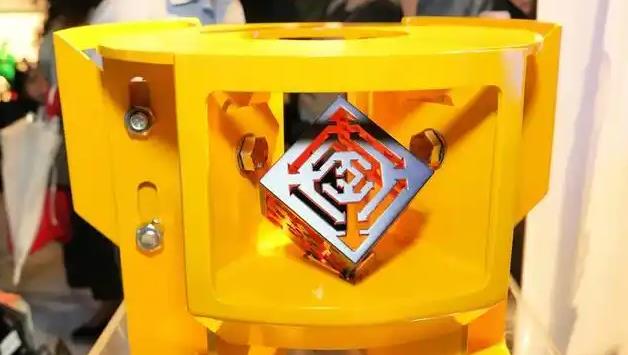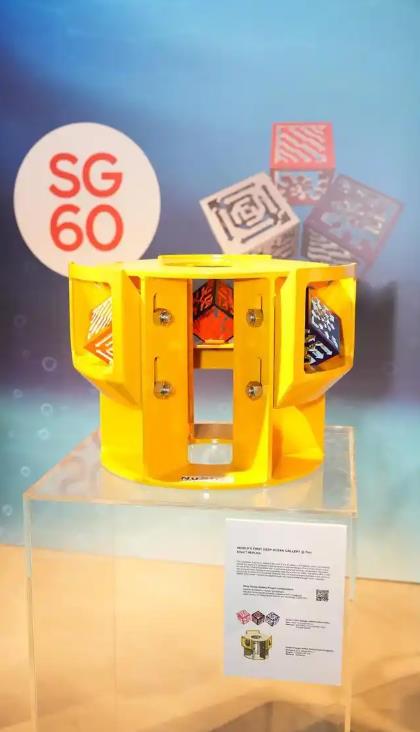新加坡成为全球首个在7000米深海底建立艺术装置的国家。这个由新加坡艺术家兼建筑师拉克希米·莫汉巴布(Lakshmi Mohanbabu)设计的三联不锈钢立方体艺术装置,于2024年12月被部署在日本附近的马里亚纳海沟区域,兼具艺术与科学双重使命。
这三个边长10厘米的立方体由耐腐蚀不锈钢制成,表面镌刻着源自"宇宙符号语言"的精密纹样。每个立方体呈现五种独特图案——鹦鹉螺纹、原生纹、次生纹、风车纹和秘境纹,分别象征人类关于创造、运动与时间等本源体验。
该项目由新加坡NuStar Technologies与日本海洋研究开发机构(JAMSTEC)合作实施,不仅是一次艺术探索,更承担着监测地震海啸的重要职能。这些立方体是专业海底震颤预警传感系统的组成部分,其中一个采用了新加坡南洋理工大学研发的混合制造技术。
由南洋理工大学3D打印中心主任赖长全教授团队开发的"激光图案化与板材集成技术(LAPIS)",将3D打印与激光切割相结合,制作出超薄不锈钢层结构。最终成型的立方体厚度仅4毫米,强度却比普通钢材高出70%,足以承受深海极端压力。
赖教授表示,该项目彰显了跨学科创新的巨大潜力。基于此技术突破,他与学生已创立初创企业,致力于将该技术应用于航空航天、海洋工程及能源领域。2024年12月12日,这些立方体被正式纳入日本"海底地震海啸密集观测网系统(DONET)"。NuStar Technologies与JAMSTEC还对原有"长期钻孔监测系统(LTBMS)"进行了针对性改造,通过定制腔体和支架实现艺术品搭载。
项目还启用了超深海摄像机全程记录装置安装过程。艺术家Mohanbabu始终走在艺术与科技融合的前沿——2022年她曾通过国际空间站"月球画廊"项目成为首位将艺术作品送入太空的新加坡人,其部分旧作还将于2025年登陆月球,使新加坡成为首个同时在地球最深海沟与外太空拥有艺术装置的国家。
此次海底艺术画廊的揭幕仪式于新加坡SG60庆典期间在ART NOW画廊举行,南洋理工大学董事会主席、新加坡国家艺术理事会主席吴瑞真出席活动。Mohanbabu将该项目视为连接人类的纽带,她主张艺术不应囿于展厅围墙,而应探索太空与深海等新疆域。
"深海对话"艺术装置旨在致敬受自然灾害影响的社群,其立方体配色蕴含深刻寓意:红白双色象征新加坡与日本的情谊,海蓝与橙色调代表地球变迁,紫色与碧蓝色则隐喻宇宙奥秘。NuStar Technologies董事总经理Goi Kim Kok指出,该项目印证了深海既能作为科研场域,亦可成为文化表达的载体。该装置同时也是2025年新日建交60周年的献礼之作。
▲Screengrab from YouTube video posted by NTUsg
▲南洋理工大学 3D 打印立方体的复制品,该立方体被送入海底。图片来源:南洋理工大学
英文原文
Singapore has become the first country to install an art gallery 7,000 meters beneath the ocean. The installation consists of three stainless steel cubes designed by Singaporean artist and architect Lakshmi Mohanbabu.
The artwork was deployed near the Mariana Trench off Japan’s coast in December 2024, serving both artistic and scientific purposes.
The cubes, measuring 10 cm on each side, are made from corrosion-resistant stainless steel and feature intricate designs inspired by the “Universal Language of Symbols.”
Each cube displays five unique patterns-Nautilus, Primary, Secondary, Windmill, and Dromenon, symbolising fundamental human experiences such as creation, movement and time.
The project was executed by NuStar Technologies in collaboration with Japan’s Agency for Marine-Earth Science and Technology (JAMSTEC). It is more than an artistic venture.
It plays an important role in monitoring earthquakes and tsunamis. The cubes are part of a specialised early warning seismic sensor system that tracks undersea tremors.
One of the three cubes was manufactured using a hybrid technique developed by researchers at Nanyang Technological University (NTU) Singapore.
This method, known as Laser Patterning and Incorporation of Sheets (LAPIS), combines 3D printing with laser cutting to create ultra-thin layers of stainless steel.
The final structure, only 4mm thick, is over 70% stronger than regular steel, enabling it to withstand extreme deep-sea pressures.
Professor Lai Changquan led the research at NTU’s Singapore Centre for 3D Printing. Changquan said that the project showcases the potential of interdisciplinary innovation.
Following the success, he and his students have launched a start-up to apply the technology in the aerospace, maritime and energy sectors.
The cubes were officially installed on December 12, 2024, and incorporated into Japan’s Dense Ocean Network System for Earthquakes and Tsunamis (DONET).
NuStar Technologies and JAMSTEC modified the Long-Term Borehole Monitoring System (LTBMS) by adding custom cavities and holders to accommodate the artwork.
Ultra-deep sea cameras were also deployed to capture images and videos of the installation. Mohanbabu has always been at the forefront of integrating art with scientific advancements.
In 2022, she became the first Singaporean to send artwork into space through the Moon Gallery project on the International Space Station.
Now, plans are in place to send her previous artworks to the Moon in 2025, making Singapore the first nation to have art installations both on the ocean floor and in space.
The underwater gallery was commemorated during Singapore’s SG60 celebrations at Gallery ART NOW. The event was attended by NTU Board Chair Goh Swee Chen, who is also the Chairman of the National Arts Council.
Mohanbabu sees this project as a way to unite people through shared experiences. She believes that art should not be confined to walls but should explore new frontiers, whether in space or deep underwater.
The Deep Ocean Interactions Project is a tribute to communities affected by natural disasters. The cube colours, red and white, ocean blue and orange, and purple and aquamarine blue, symbolise Earth’s transformation, and the mysteries of the cosmos.
The red and white cube, in particular, represents the bond between Singapore and Japan.
According to Goi Kim Kok, managing director of NuStar Technologies, this project proves that the deep ocean can serve as a space for both scientific research and cultural expression.
The installation also marks the 60th anniversary of Singapore-Japan diplomatic relations in 2025.
免责申明:本文根据NTU Singapore等内容整理,如有误差,以英文为准;仅代表作者观点,不代表中国海员之家立场。其真实性及原创性未能得到中国海员之家证实,在此感谢原作者的辛苦创作,如转载涉及版权等问题,请作者与我们联系,我们将在第一时间处理,谢谢!联系邮箱:cnisu@54seaman.com




 联系我们人工客服
联系我们人工客服



















 :1391995811
:1391995811


评论 (0人参与)